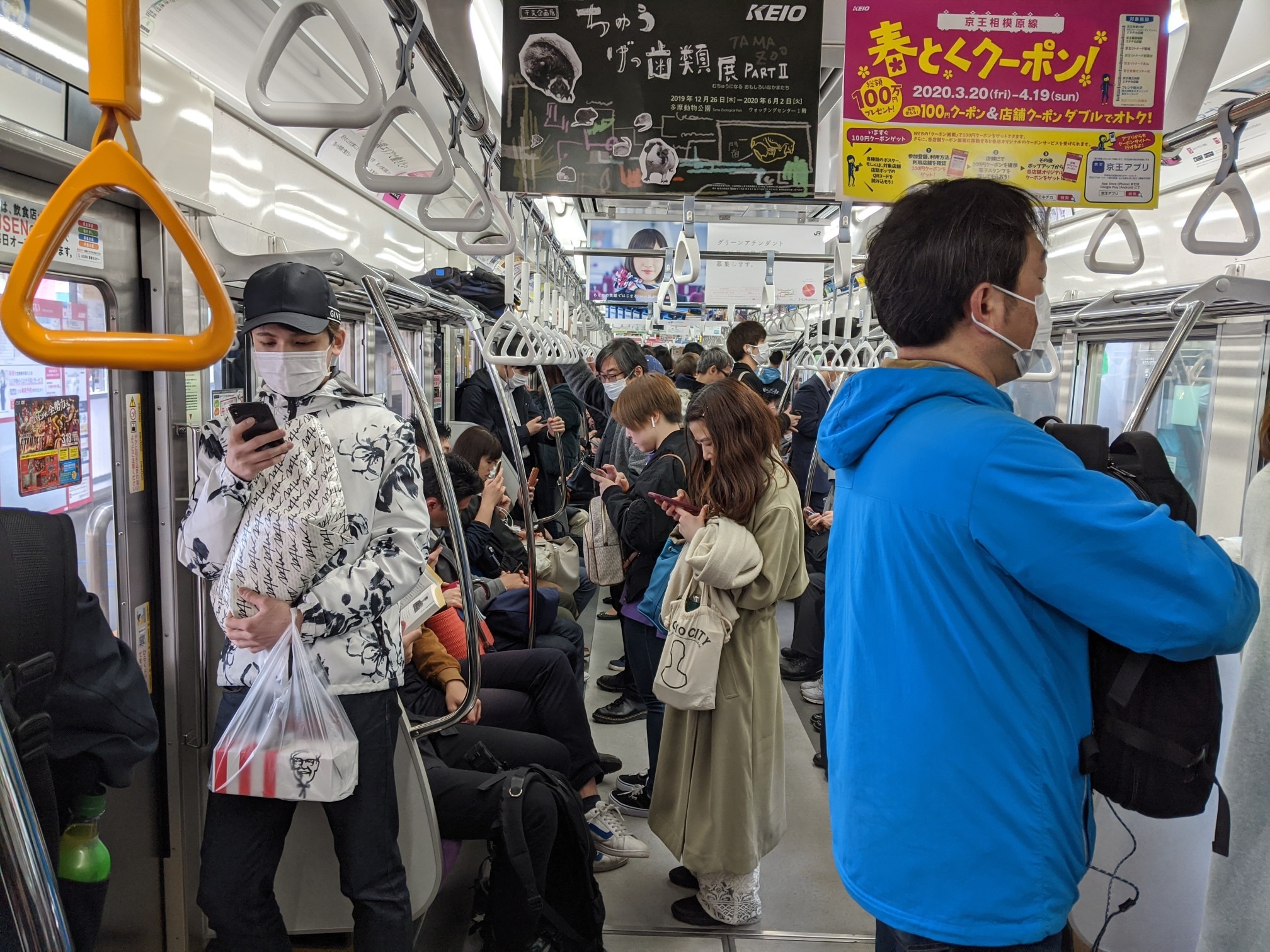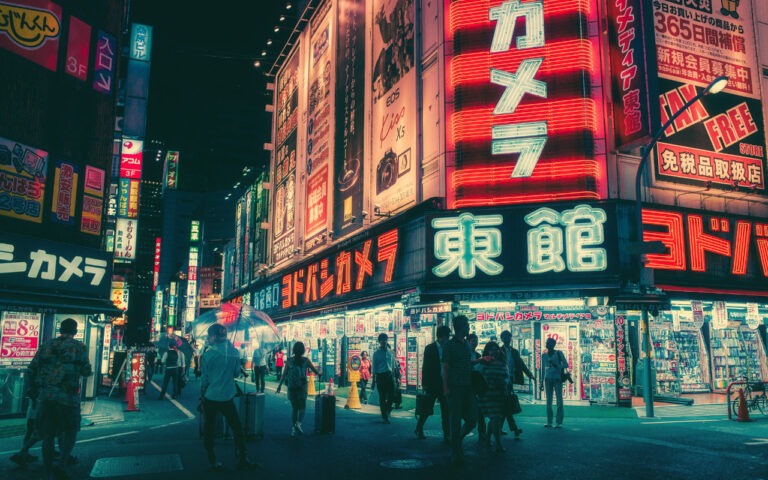Japanese Culture Isn’t Designed to Handle a Pandemic

By Richard Milner
Staff Writer
29/3/2020

Tokyo trains, 23rd March 2020
On 20th March, I returned from Finland and stepped through Japanese immigration at Haneda airport. Nothing in the airport was different. There were no quarantine areas, hazmat suits, health screenings, plastic gloves on employees, extra signage, or paperwork.
On 25th March, the day after the International Olympic Committee (IOC) postponed the 2020 Olympics, Tokyo governor Yuriko Koike finally recommended social distancing and other precautions to curb the spread of COVID-19. She urged, not ordered, Japanese citizens to stay indoors through the weekend as much as possible, eat in, and avoid congregating – recommendations that have become commonplace in all affected countries. But, aside from some hoarding of toilet paper and facemasks in February, Japanese people still behave more or less the same. They still push into trains, pack into bars, flock to parks for picnics, and sit side-by-side in coffee shops. So far, the Japanese government’s measures have only extended to setting up a coronavirus task force, ending the school year early, and requiring people entering Japan from certain countries to self-quarantine for 14 days. Whilst many other countries go into lockdown and impose severe punishments on those who flout quarantine to try to slow the spread of the virus, the Japanese attitude remains blasé.
Whilst many other countries go into lockdown to try to slow the spread of the virus, the Japanese attitude remains blasé.
Despite this, however, and despite the fact that Tokyo is the world’s most populated city and that Japan was one of the first countries to report COVID-19 cases, the country doesn’t seem to have suffered much, at least not yet. At the time of writing, Japan has around 1,500 infections and 50 deaths.
Japan has become such an anomaly, in fact, that many have wondered why there hasn’t been a COVID-19 spike. Experts at the National Institute of Infectious Diseases speculate that there are more COVID-19 cases in Tokyo than have been detected. Confusing testing protocols may be to blame, as tests for COVID-19 were not originally classified as diagnostic tests for the purposes of receiving treatment, but rather epidemiological tests meant to further research. This made availability scarce and coverage under insurance limited.

Shinjuku, Tokyo, 25th March 2020
But why has Japan been so lackadaisical about the spread of COVID-19? It comes down to culture.
One reason is because Japanese people are reluctant to make the first move. Public courtesy requires everyone to engage in the same behavior and to do their part by not disrupting the social order by displaying negative emotions like anxiety or fear, even in the middle of a pandemic (the hoarders were the outliers). The public looks to the authorities for cues on how to behave.
Unfortunately, the Japanese authorities are themselves reluctant to make the first move, looking to other countries, like the US and the UK, or international organizations, like the IOC, for cues. And so, it was only after the IOC made the first move and postponed the Olympics that Koike decided to recommend social distancing. Tellingly, only in the past couple days has food begun to run out in supermarkets; Koike’s announcement made it permissible for the public to show some of the anxiety it’s been bottling up.
Furthermore, Japan’s traditional work culture isn’t built for remote work because it relies on face-to-face interactions. Documents in Japan must still be physical, and must be physically signed or stamped, and physically mailed to recipients. Only the very young rely on and trust electronic mediums for official purposes. Japanese employees also incessantly monitor each other to gauge their level of effort, visually, and this can only be done in person. Bosses do not trust that employees are working hard enough if they can’t see it, no matter the quality of the results. And so, an employee who even suggests working from home risks appearing lazy, even now.
An employee who even suggests working from home risks appearing lazy, even now.
The Japanese service industry is loath to break with omotenashi, the notion of placing the customer first, whatever the cost. Thus, the industry is reluctant to do anything that would inconvenience customers or prevent them from taking advantage of their full service in any way. This means restaurants, cafes, and bars will refuse to “let down” their customers by closing, unless directly ordered to by the government. They’re even reluctant to implement less extreme measures like making customers sit or stand further apart to social distance, something even more difficult to do in tiny restaurants and bars in Japan.

Try social distancing here
Then there’s the Japanese tenet of gaman (the notion that circumstances must be endured with patience and dignity). This stoicism makes many Japanese prefer to suffer in silence rather than take the initiative to deviate from the behavior of the group. “What happens, happens,” goes the thinking, “and when it does, we’ll endure.”
Gaman itself ties into the sense of fatalism in the Japanese psyche. Life is transient, passes quickly, and people are like cherry blossoms that bloom for a few weeks and then wilt and die. In the face of a pandemic, this demotivates individuals from acting assertively to safeguard their own health and safety.
Japan’s culture contributes to its lassitude on COVID-19. The behavior we see is Japan’s unique way of coping with the crisis. Let’s just hope this doesn’t create the ideal conditions for the virus to spread.
Related posts:
The Culture Factor in COVID-19
Tablighi Superspreaders in Pakistan
The Moral Foundations of Anti-Lockdown Anger
Modi and His Supporters Face a COVID Reckoning
Are Anti-Lockdown Protests Legal?
Allegory in the Time of Coronavirus
Your Odds of Dying From COVID-19 Depend on How Polluted Your Air Is
The Coronavirus and the Crisis of Responsibility
FAKE NEWS | Nothing to Worry About, Says Wuhan Official From Inside Biohazard Suit
To See How Coronavirus Outbreak Might Play Out, Look at This Virtual Plague
